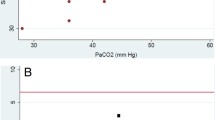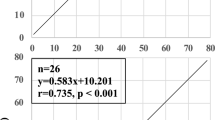Abstract
OBJECTIVE:
To determine the practical value of the new pediatric disposable ETCO2 detector Pedi-CAP in verifying endotracheal tube placement in neonatal resuscitation.
METHODS:
Infants who required endotracheal intubation in the delivery room or the neonatal intensive care unit (NICU) were included in a prospective study in which the endotracheal tube placement was determined clinically and simultaneously by the Pedi-CAP and confirmed by chest radiograph. The Pedi-CAP and clinical evaluation determination times of the endotracheal tube placement were measured and compared. The accuracy and ease of the Pedi-CAP use were tested.
RESULTS:
Forty-five newborns (450 to 4620 gm) who needed endotracheal intubation were included in the study. Twenty-four (53.3%) were intubated in the delivery room and 21 (46.7%) in the NICU. The Pedi-CAP color indicator correlated with the clinical evaluation and radiograph findings of proper intubation in 30 of 33 patients (sensitivity 91%, specificity 100%, positive predictive value 100%, and negative predictive value 80%). There were three false-negative results in patients with severe cardiorespiratory depression. The Pedi-CAP color indicator correlated with the clinical evaluation for the et-tube being in the esophagus in 12 of 12 patients (sensitivity, specificity, and positive and negative predictive value were all 100%). The time required to determine the tube position by clinical evaluation was 0 to 90 seconds (mean = 39.7 seconds; SD ± 15.3 seconds).The time required with the disposable ETCO2 detector was 4 to 12 seconds (mean = 8.1 seconds; SD ± 2.9 seconds; p < 0.001).
CONCLUSION: The use of a disposable pediatric endotracheal CO2 detector significantly reduces the time spent in verifying the endotracheal tube position (trachea versus esophagus) in newborns, including premature babies with body weight < 1000 gm. This is of particular benefit to babies who are erroneously intubated in the esophagus, because using the device allows much faster detection of this problem and much earlier reintubation.
Similar content being viewed by others
Author information
Authors and Affiliations
Rights and permissions
About this article
Cite this article
Aziz, H., Martin, J. & Moore, J. The Pediatric Disposable End-Tidal Carbon Dioxide Detector Role in Endotracheal Intubation in Newborns. J Perinatol 19, 110–113 (1999). https://doi.org/10.1038/sj.jp.7200136
Published:
Issue Date:
DOI: https://doi.org/10.1038/sj.jp.7200136
- Springer Nature America, Inc.
This article is cited by
-
Non-invasive carbon dioxide monitoring in neonates: methods, benefits, and pitfalls
Journal of Perinatology (2021)
-
Versorgung und Reanimation des Neugeborenen nach der Geburt
Notfall + Rettungsmedizin (2021)
-
A novel training simulator for portable ultrasound identification of incorrect newborn endotracheal tube placement – observational diagnostic accuracy study protocol
BMC Pediatrics (2019)
-
Initial Management of the Extremely Low-Birth-Weight Infant
Current Treatment Options in Pediatrics (2017)
-
Assessment of endotracheal tube placement in newborn infants: a randomized controlled trial
Journal of Perinatology (2016)




